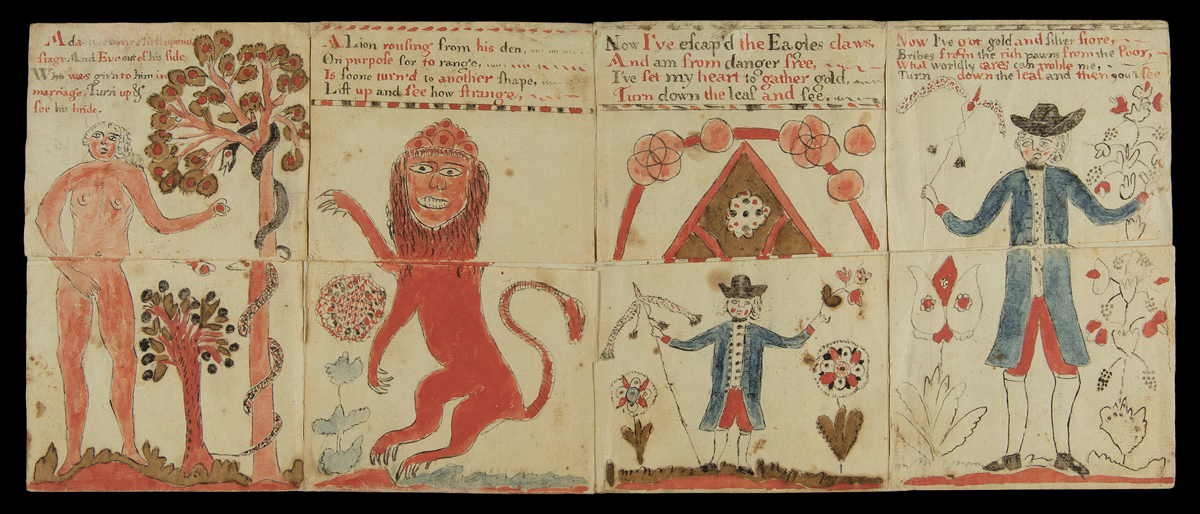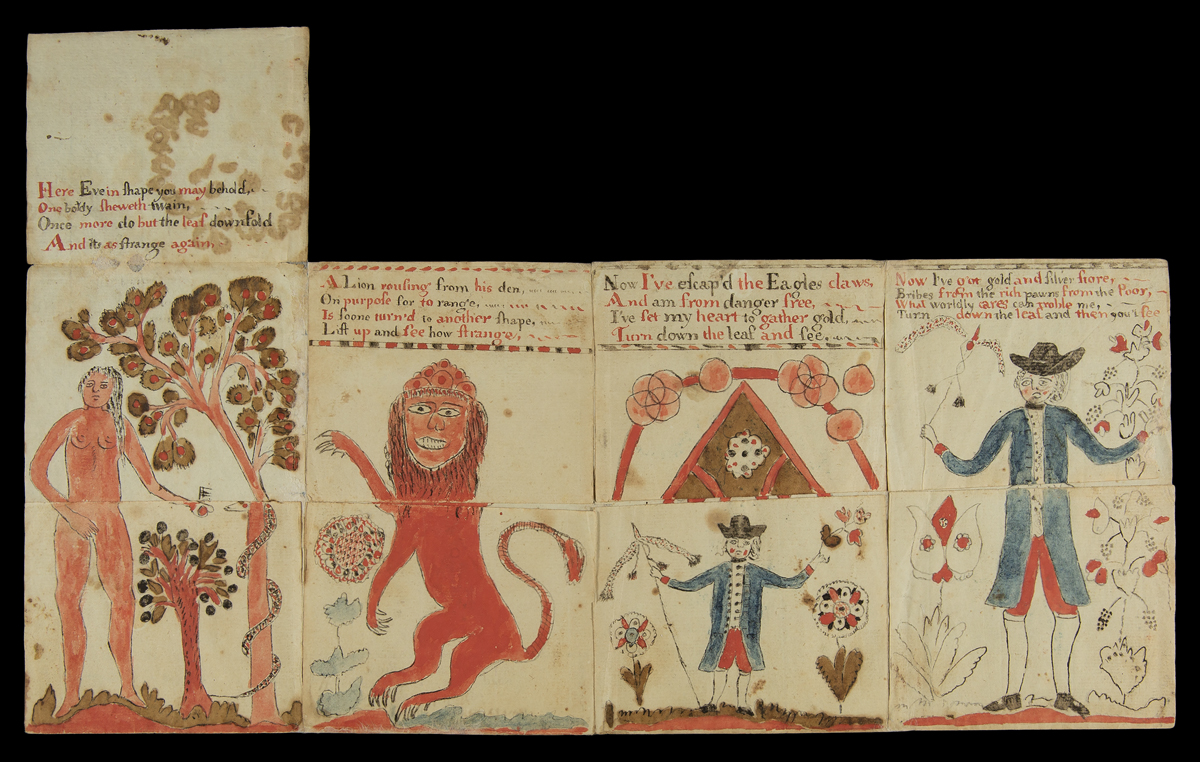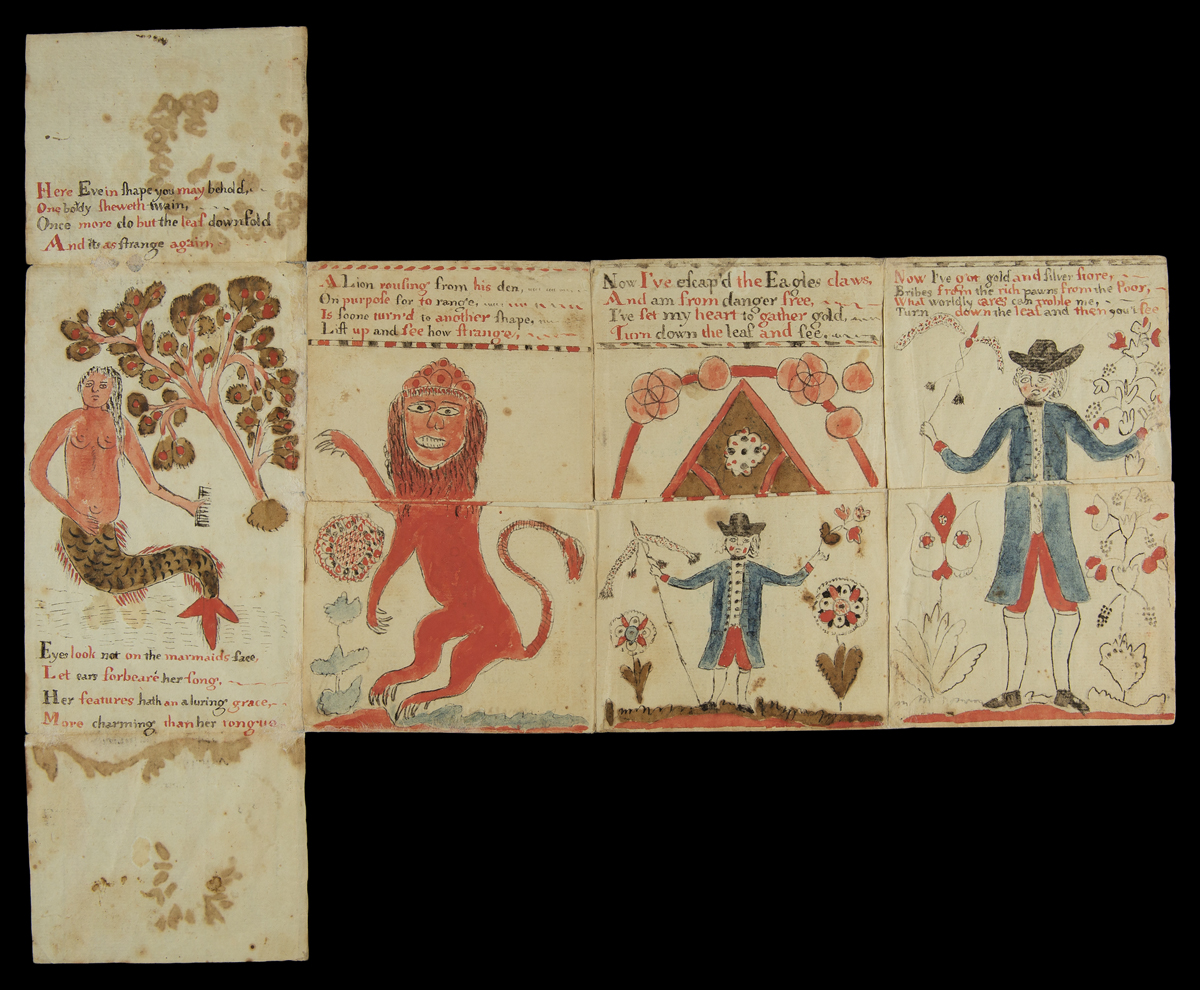"Turn Down the Leaf and See": Read, See, Touch, Lift, Learn

Metamorphosis Turn-Up Book, 1790-1820 / THF715860
Boxed and tucked away for many years in the Benson Ford Research Center archives at The Henry Ford, this turn-up book has found a new life — a metamorphosis — much like its title. This "book" — a sheet of cut and folded paper — engaged the reader in tactile learning and instilled moral lessons in interactive ways, conveying lessons and meaning through visual images and texts that change with the lift of a flap.
Movable and Turn-up Books
For hundreds of years, artists, illustrators, publishers, designers, and paper engineers have added motion and 3-dimensional depth to the flat pages of books and other paper-based media. Early examples of movable books date to the thirteenth century and involved the use of volvelles — a movable paper disk or wheel — and flaps. Designed as teaching tools for adult learners, scholars of science, religion, and philosophy manipulated these movable elements to predict astronomical events, plot yearly spiritual holidays, teach anatomy and other medical disciplines, and aid navigation, among other uses.
Eighteenth-century transformations in childhood education from strict rote learning to a more active model made movable books an appealing option for teaching children. By the mid- to late 18th century, publishers began selling printed flap or turn-up books for a wider readership that included adults and children. These sheets of cut and folded paper lured readers to interact with its pages filled with stimulating images and poetic texts that changed when readers lifted or folded down flaps. In the United States, printed versions of Metamorphosis or A Transformation of Pictures with Poetical Explanations for the Amusement of Young Persons presented a series of moral tales on movable pages and, as the title states, were directed toward a younger audience.
Metamorphosis
Metamorphosis or A Transformation of Pictures with Poetical Explanations for the Amusement of Young Persons traces its origins to earlier turn-ups such as the mid-1600s English publication The Beginning, Progress and End of Man. These early turn-ups instilled religious and moral lessons (and perhaps exposed political preferences as well) through images and verse — aspects that later authors copied, modified, and recontextualized in printed and handmade versions.
The Henry Ford's handmade version of Metamorphosis or A Transformation of Pictures consists of four panels and dates from the late 18th or early 19th century. Each panel contains two intersecting flaps; one turns up, the other down. Panels transform not once but twice, imparting moral lessons through religious, mythological, and heraldic iconography and poetic texts. First, Adam in the Garden of Eden changes to Eve — who then transforms into a mermaid. Next, a lion transforms into a mythical griffin and finally into an eagle, grasping a young child to carry him off. The third panel depicts the grown child as a young man eager to make money no matter the cost. The last panel shows what awaits the man who follows such a path: disease and death.

The first panel shows Adam in the Garden of Eden. The verse begins:
Adam comes first upon the
stage And Eve out of his side
Who was giv'n to him in
marriage, Turn up &
See his bride.

As the reader lifts the flap to reveal Eve, the verse continues:
Here Eve in shape you may behold,
One body sheweth twain
Once more do but the leaf downfold
And its [sic] as strange again,

Next, the reader turns down the flap to reveal a "marmaid," as the verse concludes:
Eyes look not on the marmaids [sic] face,
Let ears forbeare [sic] her song.
Her features hath an aluring [sic] grace,
More charming than her tongue.
It is unfortunate that the artist and owner histories of this Metamorphosis turn-up book have been lost. Similar handmade versions from the early 1700s to the late 1800s in other library collections exist, with only some including an artist's name. These examples have been an invaluable source for researching our copy. Curators at The Henry Ford — examining the book's form, texts, and imagery, including stylistic clues in the man's dress and the ornamentation on the later panels — believe this turn-up book may have been made in Pennsylvania, sometime between 1790 and the first decades of the 1800s.
Speculation continues about the artistic origins of this book. Was this made by a young woman as part of her education, promoting art and writing skills that would aid her later in life, or was this something a new mother crafted for her children to reinforce moral lessons? What we do know is that this once-hidden gem is part of a larger collection of turn-up books scattered in museums and libraries across the nation that may shed light on the beliefs, educational practices, and life of Americans in the early years of the republic.
Resources
For more information and to see other turn-up books like the one in the collection of The Henry Ford, see the following:
"Learning as Play: An Animated, Interactive Archive of 17th- to 19th- Century Narrative Media for and by Children." The Pennsylvania State University, 2019. https://sites.psu.edu/play/
Sperling, Juliet. "Unfolding Metamorphosis, or the Early American Tactile Image." American Art, 35, (3) 58-87. 2021.
Reid-Walsh, Jacqueline. "Format and Meaning-Making in Religious Turn-Up Books: The Remediation of The Beginning, Progress and End of Man into Metamorphosis, or a Transformation of Pictures: With Poetical Explanations for the Amusement of Children." [Chapter 10] in Forms, Formats and the Circulation of Knowledge: British Printscape's Innovations, 1688-1832. Ed. by Louisiane Ferlier and Bénédicte Miyamoto. (Library of the Written Word, 83; The Handpress World, 64.) Leiden and Boston: Brill. 2020.
Andy Stupperich is an associate curator at The Henry Ford.


Facebook Comments